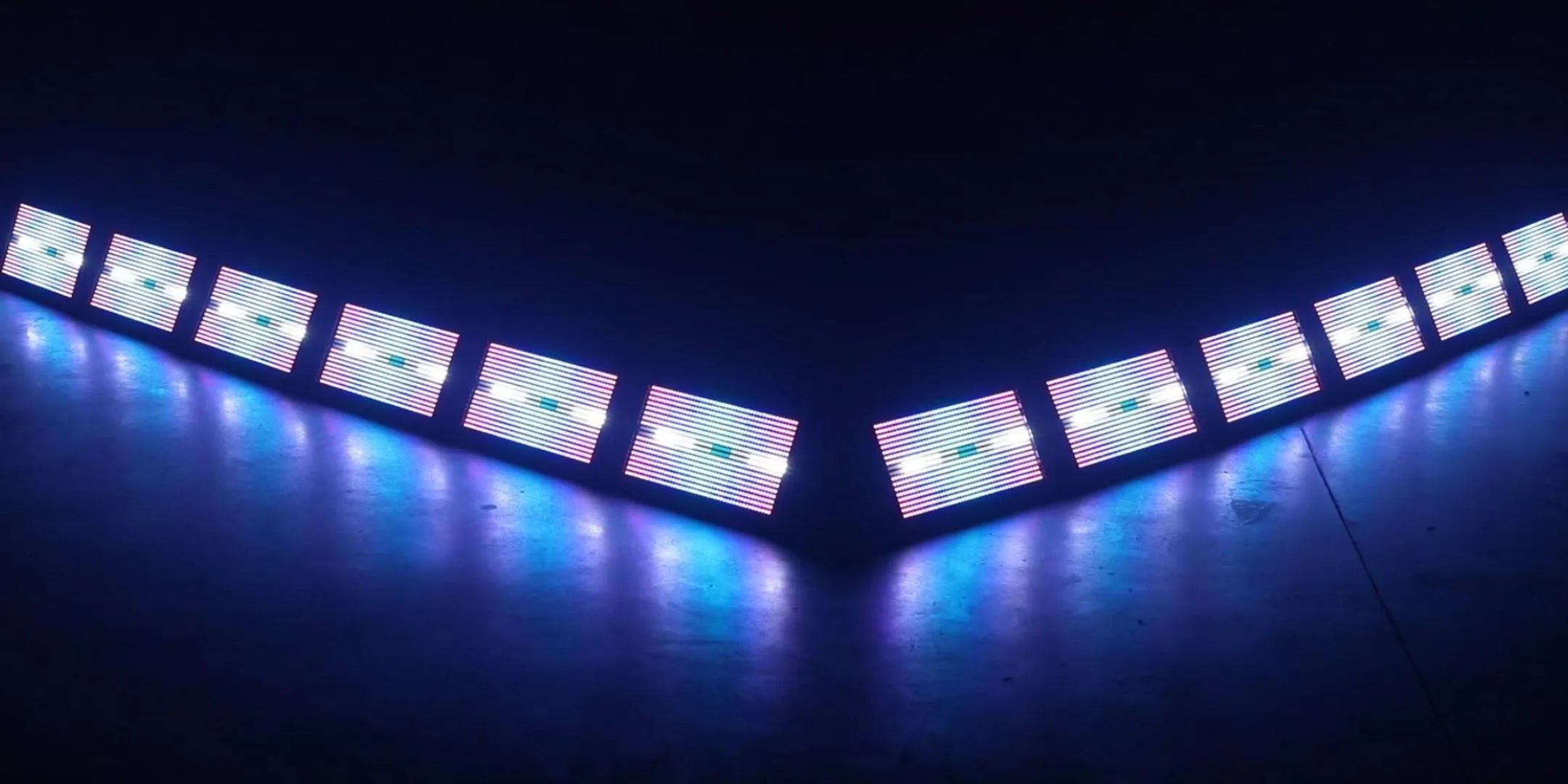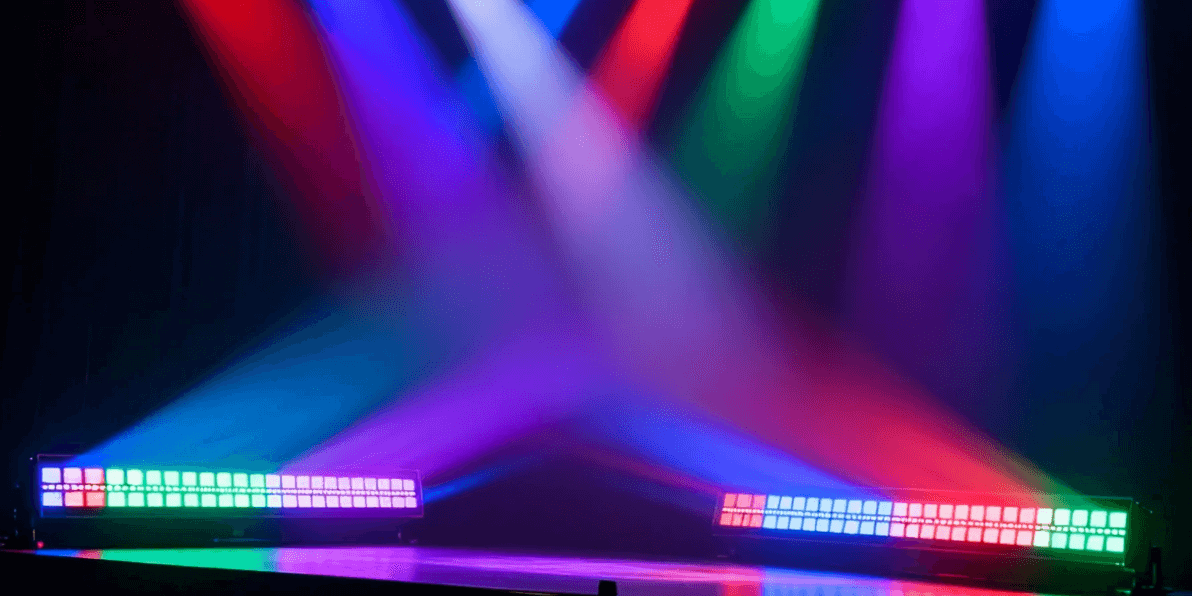What Is Pixel Mapping?
Pixel mapping is a control method that assigns video content, animations, or visual data to individual LEDs or pixel zones within a lighting fixture.
Instead of controlling a fixture as a single unit (color, dimmer, strobe), each LED or pixel becomes an addressable point on a visual grid.
In simple terms:
Traditional DMX control:
One fixture = one look at a time
Pixel mapping:
One fixture = dozens or hundreds of independently controlled pixels
This transforms lighting fixtures—such as pixel bars, pixel strobes, LED panels, and even floor strips—into dynamic displays capable of:
- wave animations
- color gradients
- flowing visual textures
- video-driven effects
- beat-reactive motion graphics
Lighting becomes part of the show’s visual media, not just illumination.
1. Lighting Becomes Motion Graphics
In traditional programming, effects are repeated fixture by fixture. Pixel mapping changes this completely.
When multiple pixel fixtures are mapped into the same visual canvas:
- waves sweep across the stage
- gradients shift across trusses
- animations flow from left to right
- light “moves” through space
- colors pulse in rhythm with the music
The result is kinetic, flowing visuals that feel alive and immersive—especially in large venues.
2. Perfect Integration With Video, Timecode, and Music
Pixel mapping seamlessly connects lighting with:
- media server outputs (Resolume, ArKaos, Madrix, Notch)
- timecoded sequences
- video playback
- audio-reactive plugins
This allows designers to synchronize lighting motion with:
- video content playing on LED screens
- musical cues
- drop effects
- stage transitions
Pixel mapping creates full sensory synchronization, making lighting an extension of video and sound.
3. Arena-Scale Immersion Through Unified Visual Canvases
Pixel mapping allows designers to merge dozens of fixtures into one cohesive visual system. For example:
- Pixel bars along the truss create directional sweeps
- Strobes on the perimeter create rhythmic pulses
- LED strips on the stage floor create movement pathways
- Vertical pixel bars behind the artist create visual depth
Instead of isolated one-off effects, the entire lighting rig behaves like a giant animated screen.
This level of cohesion is impossible with traditional DMX control alone.
4. Advanced Stage Effects That Traditional Control Can’t Do
Pixel mapping enables effects such as:
- 3D motion illusions
- “Waterfall” or “rainfall” visuals
- countdown-style sweep animations
- explosion-style bursts across the stage
- heat-map style movement
- spatial gradients
- multi-fixture waveforms
These effects bring a cinematic quality to concerts and make even minimal rigs feel significantly larger.
5. Greater Emotional Storytelling Through Light
Pixel mapping helps concerts match the emotional shape of the music:
- gentle animations during intros
- rising waves during build-ups
- synchronized movement during choruses
- explosive multi-pixel bursts during drops
- flowing, atmospheric motions during ballads
Lighting no longer reacts to music—it expresses music.
6. More Impact With Fewer Fixtures
Because pixel mapping multiplies the creative output of every fixture, designers can achieve massive looks using fewer lights:
- fewer fixtures
- fewer cables
- fewer DMX universes
- faster setup and teardown
- lower load on truss structures
Pixel mapping increases both visual impact and technical efficiency.
FAQ: Pixel Mapping in Concert Lighting
1. Is pixel mapping difficult to learn?
Not necessarily. Most modern lighting consoles provide built-in pixel engines that simplify workflow.
2. Do I need a dedicated media server?
For large rigs, yes. For smaller rigs, consoles like MA3, Chamsys, and Onyx offer strong built-in pixel mapping tools.
3. What fixtures can be pixel-mapped?
Any fixture with individually controllable LEDs—such as pixel bars, pixel strobes, strips, and LED matrices.
4. Is pixel mapping only for big concerts?
No. It’s effective in any venue, but its impact scales dramatically with larger stages.
Conclusion
Pixel mapping has transformed what modern concert lighting can achieve—turning fixtures into animated visual elements, synchronizing lighting with music and video, and creating immersive motion across the entire stage.
For lighting designers and production teams, it is now one of the most essential tools for building large-scale, emotionally impactful concert experiences.
To explore pixel-ready lighting fixtures and build your own pixel-mapped stage design: https://betopperdj.com/





Lascia un commento
Nota che i commenti devono essere approvati prima di essere pubblicati.
Questo sito è protetto da hCaptcha e applica le Norme sulla privacy e i Termini di servizio di hCaptcha.